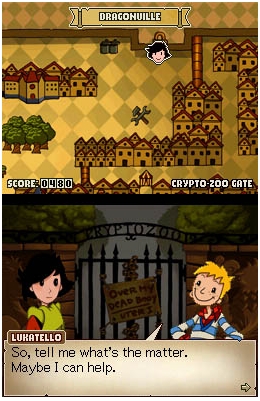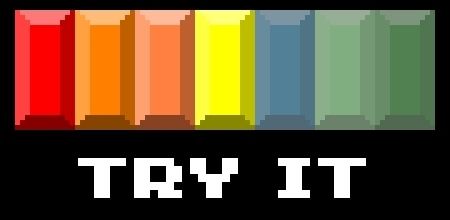
Following the strong success of the Professor Layton series, the Londoner’s unique brand of puzzle and logic gaming has been picked up by other DS and 3DS titles. Many of the games in the genre seem to have struck a chord with a large and diverse audience of handheld gamers – something that the DS’ other lesser-known puzzle titles have failed to achieve. A few weeks ago the DS became home to another point-and-click logic puzzler, May’s Mystery: Forbidden Memories, a title that I had impulsively picked up to hold me over until the long-awaited Professor Layton and the Last Specter finally released. As expected, that’s all it was good for anyway.
Platforms: DS
Publisher: SVC Distribution
Developer: Red Wagon Games/Studio V5
Genre: Layton Look-Alike Puzzler
Release Date: September 28, 2011
ESRB Rating: Everyone
Dating back to the first point-and-click games like Monkey Island, Myst, or Sam & Max, some involved puzzle-solving, and some simply involved an inventory system where the player could use an item in their inventory to progress the story further by bribing characters, opening a door, or initiating a conversation necessary to push the plot along. The puzzle-solving variety of point-and-click games seldom laid out text contributions to the puzzles, requiring players to figure out the puzzles’ premise and solution entirely on their own.
It pains me to say this, but we’re not all that smart; in the handheld market, not everyone has time to be hung up on a puzzle for hours or days, either. That’s where the handheld continuations of the genre enter the stage: creating a simpler, light-hearted, and fun experience that appeals to a wider group of gamers. Even though the Layton series found success when utilizing this idea, every trailblazer will have its followers – especially where sales are concerned. May’s Mystery is not a clone so much as it is a follower.
The game opens with a cutscene of May Stery – the lead character – flying in a hot air balloon with her brother Teri. But disaster strikes when the balloon crash-lands into a town named Dragonville. When May awakens after the crash, Teri is gone and she learns that the town is in disarray due to an evil mastermind who seeks to gain the town’s control from Mayor Doyle – an unnecessarily mysterious and oddly brash character who has been stripped of his power and pointlessly appears to have ulterior motives while helping May through Dragonville and its puzzles. Many of Dragonville’s townspeople seem incapable of logical thought – an apparent flaw with the game’s writing. Characters will often jump from one subject to the next while May struggles to keep up, and this poor dialogue often tears apart any shred of a real plot that May’s Mystery would hope to have.
 In addition to the confusing banter with townsfolk, the key items that May is asked to retrieve are unusually odd and pointless; one such escapade had me solving puzzles in order to eventually collect a vial of cream for a character to rub on himself, only after which he finally told me where my next destination was. Not only are the story elements often foggy and confusing, but the puzzle descriptions often bear the same weakness. Trust me when I say that there is nothing harder than trying to solve a puzzle when you don’t know what solution you’re looking for.
In addition to the confusing banter with townsfolk, the key items that May is asked to retrieve are unusually odd and pointless; one such escapade had me solving puzzles in order to eventually collect a vial of cream for a character to rub on himself, only after which he finally told me where my next destination was. Not only are the story elements often foggy and confusing, but the puzzle descriptions often bear the same weakness. Trust me when I say that there is nothing harder than trying to solve a puzzle when you don’t know what solution you’re looking for.
As far as originality goes, May’s Mystery actually does bring a welcome change to its puzzle styles. In addition to offering the standard Layton-style puzzles – which is to be expected – this game does present a variety of new puzzle styles, such as a variant on Picross and I Spy-inspired search puzzles. At various points throughout the game, additional bonus puzzles are made available to the player – these can be solved in order to accumulate Hint Points. Hint Points can be used to obtain up to two hints per puzzle, or the player can spend 15 Hint Points to skip any puzzle in the main game altogether. May’s Mystery also doesn’t contain hidden Hint Points in the same way that Layton can find hidden Hint Coins in the environments. Instead, the player must solve additional bonus puzzles to receive their Hint Points.
Though the art quality of May’s Mystery came off as that of placeholder art, it seemed to fit the rest of the game’s environment well, but never really portrayed a specifically uniform art style in the same way as the Layton series. May’s Mystery does include fully animated and voiced cutscenes as well, but again, the quality of these cutscenes greatly differ from the production of Professor Layton’s.
All in all, May’s Mystery – in most cases – really is a poor man’s Professor Layton. Aside from a few new puzzle styles and a change of scenery, there is no implicit reason to prioritize this game over better ones in the genre. That being said, this game was perfect for the exact reason I played it – to keep the puzzles coming after you’ve played all the rest, or simply for a change of scenery. I enjoyed it much more than I initially expected to. Plus, it never hurts to support the smaller developers – maybe May’s Mystery 2 could be even better!

Review Disclosure: A retail copy of May’s Mystery: Forbidden Memories was purchased by Warp Zoned for the purposes of this review.






